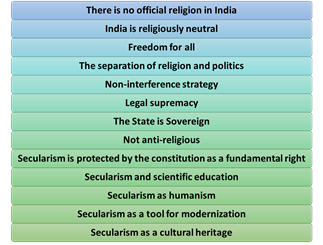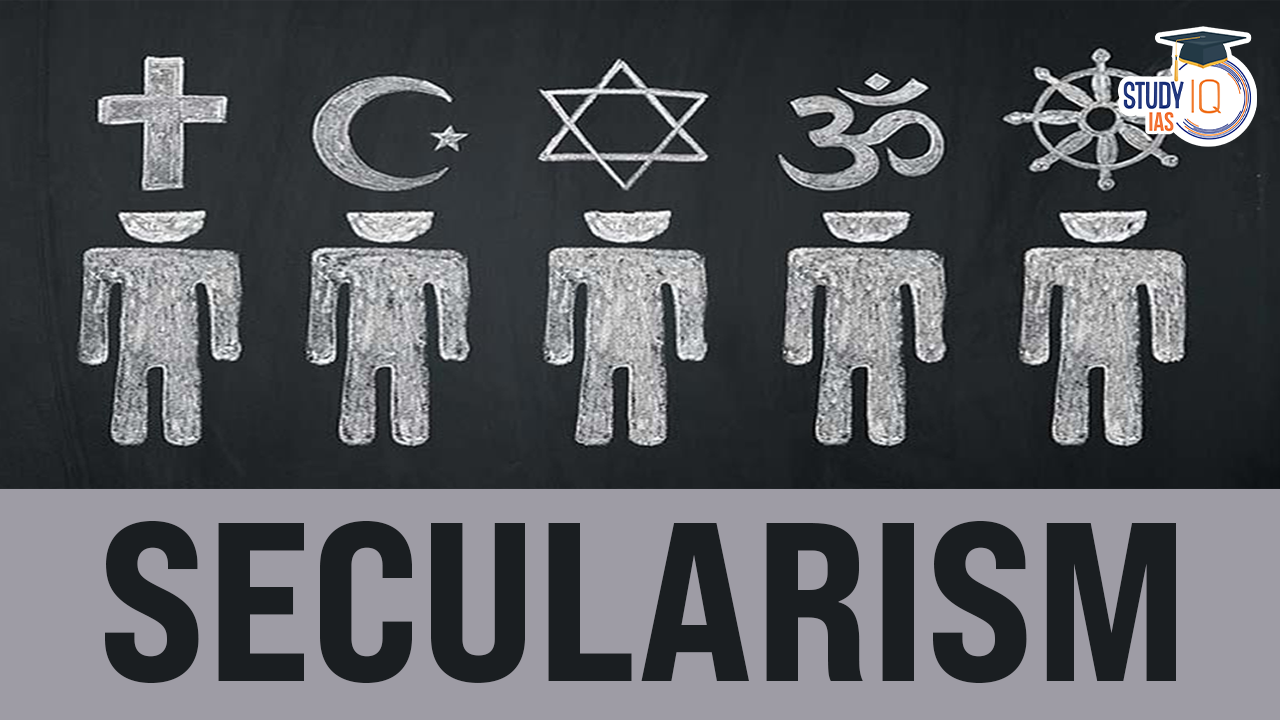Table of Contents
The court made the oral observation while hearing a batch of petitions filed by former Rajya Sabha member Subramanian Swamy and others challenging the inclusion of the words “socialist” and “secular” in the Preamble to the Constitution.
What is Meant By Secularism?
- It refers to the principle of separation between government institutions and religious institutions.
- In the Indian context, secularism means equal treatment of all religions by the state, without favouring or discriminating against any religion.
- The Indian model of secularism is based on the idea that the state should neither support nor interfere with religious affairs, while ensuring that citizens are free to practise their religion.

Key Articles and Constitutional Amendment Reflecting Secularism
- Article 14 – Right to Equality: Guarantees equality before the law and equal protection of laws to all individuals, ensuring that no one is discriminated against based on religion.
- Article 16(1) – Equality of Opportunity: Ensures equality of opportunity for all citizens in public employment and prohibits discrimination on the basis of religion, race, caste, sex, descent, place of birth, or residence.
- Article 25 – Freedom of Conscience: Provides every person with the right to freedom of conscience and the right to freely profess, practice, and propagate their religion.
- Article 26 – Right to Manage Religious Affairs: Grants every religious group or individual the right to establish and maintain institutions for religious and charitable purposes and manage their own affairs in matters of religion.
- Article 27 – Prohibition of Religious Taxation: States that the government shall not compel any citizen to pay taxes for the promotion or maintenance of any particular religion or religious institution.
- Article 28 – Religious Instruction in Educational Institutions: Allows educational institutions maintained by different religious groups to impart religious instruction, provided they do not receive state funding.
- Articles 29 and 30 – Cultural and Educational Rights: Provide rights to minorities to preserve their culture and establish educational institutions of their choice.
- Article 51A – Fundamental Duties: Obligates citizens to promote harmony and the spirit of common brotherhood among all people and preserve the rich heritage of India’s composite culture.
- 42nd Constitutional Amendment Act (1976): This amendment added the word “secular” to the Preamble of the Constitution, defining India as a republic that respects all religions equally.
Difference Between Indian Model of Secularism and Western Model of Secularism
| Aspect | Indian Model of Secularism | Western Model of Secularism |
| Concept | Equal respect and recognition for all religions by the state. | Strict separation between the state and religion. |
| State and Religion | The state can intervene in religious matters to ensure social reform and equality (e.g., abolition of untouchability, reform in religious laws). | The state maintains complete detachment from religious affairs, neither supporting nor interfering in religious practices. |
| Religious Freedom | Allows the state to support religious practices if they promote public welfare, such as providing funds to religious schools. | Ensures the state neither supports nor funds any religious activity or institution. |
| Religion in Public Life | Religion is allowed in public life, and religious practices are accommodated in state-run institutions (e.g., holidays for festivals). | Religion is strictly confined to the private sphere, with minimal public expression in state institutions. |
| Treatment of All Religions | The state maintains a “principled distance” from all religions, recognizing all equally without favouring any specific religion. | The state does not recognize or endorse any religion; neutrality is maintained without direct acknowledgment of religious identities. |
| Intervention | The state may intervene in religious practices to ensure constitutional values like equality, liberty, and social justice (e.g., reforming personal laws, banning discriminatory practices). | The state rarely intervenes in religious matters unless they violate public law or threaten public order. |
| Secularism in Education | Religious instruction is allowed in private or minority institutions, but state-funded institutions are prohibited from giving religious instruction. | Public educational institutions are completely free from any religious instruction or influence. |
| Focus | Promotes religious tolerance and harmony among different religious communities. | Focuses on protecting individual rights and ensuring religion does not influence state affairs. |
| Examples | India, Bangladesh, Indonesia (to some extent) | United States, France, United Kingdom |
| Basis of Secularism | Pluralism and positive engagement with religions to ensure equality. | Absolute separation and neutrality to ensure individual freedom from religion. |
What are the Challenges Associated?
- Communal Violence: Incidents of communal riots, such as the 2013 Muzaffarnagar riots, highlight the fragility of communal harmony in India.
- These riots resulted in significant loss of life and displacement, underscoring the tensions between different religious communities.
- Such violence not only disrupts social fabric but also erodes trust in secular governance, leading to increased polarisation among communities.
- Political Mobilisation Based on Religion: Political parties have increasingly mobilised support along religious lines.
- Example: The rise of parties campaigns that emphasise Hindu nationalism, which marginalised minority communities.
- This trend undermines the secular nature of the state by promoting a particular religious identity over a national one, leading to fears of discrimination among non-Hindu populations.
- Judicial Challenges: The Supreme Court’s decisions on matters like Ayodhya have sparked debates about the intersection of law and religion.
- The verdict in favour of constructing a Ram temple on disputed land was seen by many as a departure from strict secularism.
- Such rulings can create perceptions of bias within the judiciary, raising concerns about its role as a protector of secular values.
- Cultural and Educational Rights of Minorities: The implementation of policies affecting minority educational institutions has led to tensions.
- Restrictions on minority institutions can lead to feelings of alienation and undermine the pluralistic ethos that secularism seeks to promote.
- Economic Disparities and Social Inequities: Economic policies that disproportionately affect minority communities can exacerbate existing inequalities.
- Media Representation and Bias: The portrayal of religious communities in media narratives often reflects biases that can exacerbate communal tensions.
- Biased media coverage can influence public perception and fuel stereotypes, undermining efforts toward fostering communal harmony.
Way Forward
- Strengthening Legal Frameworks: Implement stricter laws against hate speech and communal violence to ensure accountability for actions that undermine secularism.
- Promoting Interfaith Dialogue: Encourage initiatives that foster dialogue between different religious communities to build understanding and trust.
- Judicial Reforms: Ensure that judicial decisions reflect a commitment to secular principles by promoting diversity within the judiciary and enhancing transparency in decision-making processes.
- Inclusive Economic Policies: Develop targeted economic programs aimed at uplifting marginalised communities, ensuring equitable access to education and employment opportunities.
- Media Literacy Programs: Promote media literacy initiatives that educate citizens about responsible media consumption, helping them discern bias and misinformation.
- Civic Education: Incorporate civic education into school curricula that emphasises constitutional values, including secularism, tolerance, and respect for diversity.
| Previous Year Question Related to the Topic (UPSC CSE Mains) |
| Q. “Are tolerance, assimilation and pluralism the key elements in the making of an Indian form of secularism? Justify your answer”. [2022]
Q. “What are the challenges to our cultural practices in the name of secularism?” [2019] Q. “How is the Indian concept of secularism different from the western model of secularism?” Discuss. [2018] Q. “How do the Indian debates on secularism differ from the debates in the West?” [2014]. |


 New Phase of Operation Chakra to Combat ...
New Phase of Operation Chakra to Combat ...
 Soyuz Aircraft: History, Design and Sign...
Soyuz Aircraft: History, Design and Sign...
 Topological Materials: The Future of Qua...
Topological Materials: The Future of Qua...





















